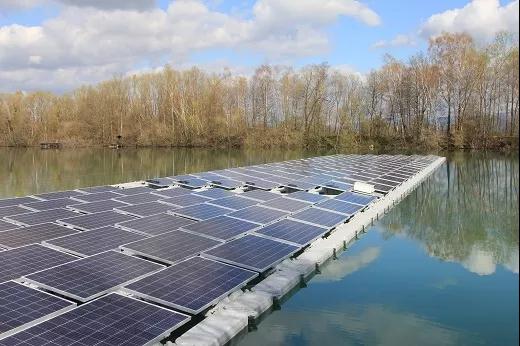The biggest challenge of floating photovoltaic on water surface lies not on water surface. The anti PID solutions under high temperature and high humidity have been mature for a long time.
The biggest challenge of water floating photovoltaic is not PV. The economy and reliability of photovoltaic products have been improved.
The biggest challenge of water floating photovoltaic is float. How to make floating photovoltaic products (like solar panels, floating solar mountings, etc) float is not difficult, but how to make photovoltaic products float for 25 years!!
In order to make the components float on the water surface, the industry generally uses pontoons, pontoons, etc. The biggest challenge for floating materials is water resistance and weather resistance.
-Water resistance: since photovoltaic products are carried on the water surface, they must bear the erosion of water environment. The water resistance itself is a test for all kinds of materials. The floating body of water floating photovoltaic should consider various water environment, including temperature, ionic impurities in water, etc. Metal seems to be strong, but when it comes to water, its life is greatly reduced. Therefore, from the point of view of economy and corrosion resistance, polymer materials were chosed for most of the floating body schemes, and even cement pontoon rather than metal are preferred to choose.
-Weather resistance: as the name implies, the floating body is not only in water, but also partially exposed to the water surface. The part exposed to the water must consider the weather resistance, including ultraviolet resistance, high temperature resistance and water vapor resistance. Weatherability is the biggest challenge to the service life of polymer floating materials.
According to the construction situation of floating photovoltaic power station at home and abroad, the technical scheme of buoyancy system of power station mainly includes the following two categories:
1. HDPE (high density polyethylene) floating body scheme: all buoyancy and structural forces in this scheme are provided and carried by HDPE floating body.
2. Floating body + steel structure scheme: in this scheme, the buoyancy is provided by the floating body, and the structural stress is carried out by steel support members.
Compared with the characteristics of concrete floating body, such as brittleness, fragility, bulky and difficult to process, PP polypropylene material has the characteristics of low-temperature cold brittleness, non hollow blow molding material, and difficult processing. Stainless steel floating body has high cost, thin-walled stainless steel is easy to rust through and difficult to install. HDPE is the best product to solve the water land connection problem.
Polyethylene floating body has good performance and reasonable price. Under the same conditions, the price of photovoltaic panel and inverter is fixed, and the cost of using polyethylene floating body is about 1/4 of the cost of steel support. In addition, it is environmentally friendly and basically maintenance free. Whether it is deep water, shallow water, moving water, still water, salt water, fresh water, frozen water, hot water, purified water, sewage, almost as long as there is water, the floating body can make full use of it. All kinds of products composed of floating body have the characteristics of infinite variety, free combination into various shapes, simple and rapid installation and disassembly, harmless to the environment, light, stable and safe, 100% maintenance free and so on.
However, no matter how good HDPE is, as a polymer material, anyone will doubt its weather resistance and service life. Generally, the materials with the best weather resistance are fluorine-containing materials, such as PVF and PVDF used for backboard, but the price is not around the threshold. If it is HDPE, can it meet the 25 year requirement of photovoltaic industry?
If the service life of the floating photovoltaic power station is less than 25 years due to the floating body, if the buoy is replaced 1-2 times or more times, the consequences will be unimaginable. It is not only the replacement of floating body very troublesome, but also the cost of single watt which will be more than 6 Yuan. This is bound to be a loss that the power station investor cannot bear. It will double the payback period of photovoltaic power stations, and more likely to invest 100 million Yuan.
3. The floats on water surface need the demonstration urgently.
As for the relevant industry standards of floating body materials, people of insight in China have started to formulate. However, no matter what kind of industry standard, it will eventually be tested by outdoor practical application. Therefore, as the most close to outdoor application, outdoor empirical test specifications and standards also need to be discussed by relevant departments as soon as possible. China has Hainan's high temperature and humidity and marine environment, Lhasa plateau high ultraviolet environment, Hailar extremely cold environment. It may be of great significance to carry out the outdoor demonstration application of floating materials for China's water surface floating solutions to the world, and for the Chinese certification authority to provide technical support for the application of global floating PV on water surface.

